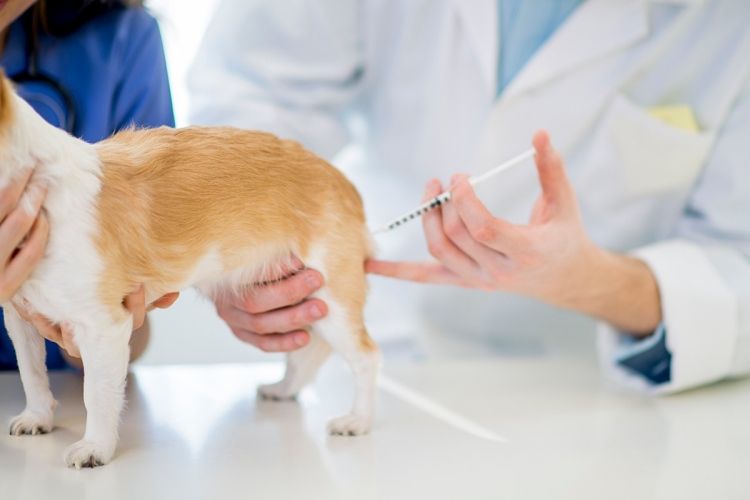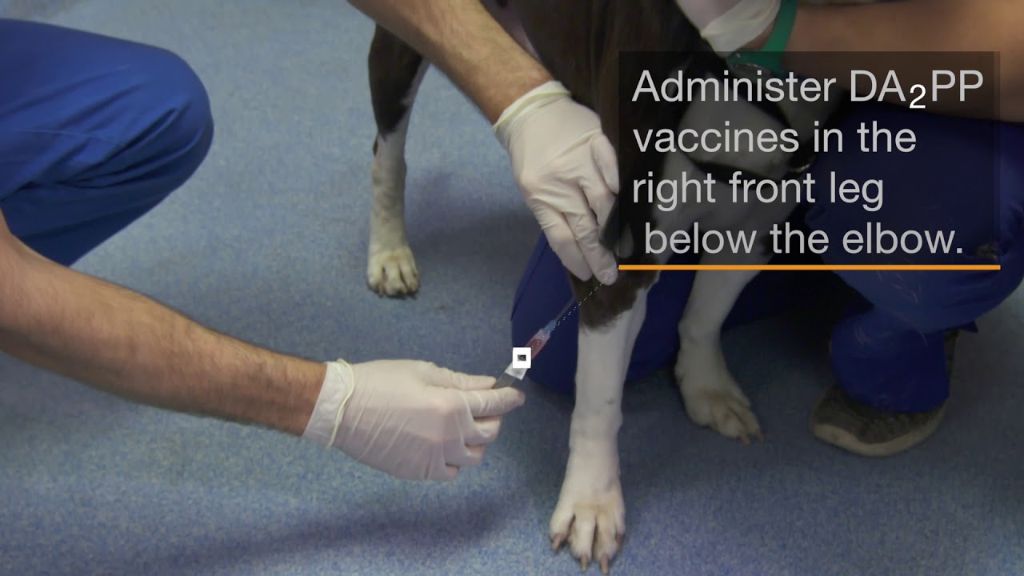Introduction
Rabies is a viral disease that affects the central nervous system of mammals, including dogs. It is spread through the saliva of infected animals and is almost always fatal once clinical signs occur. Rabies vaccinations are crucial for protecting dogs against this deadly virus.
Rabies is found throughout most of the world, with more than 59,000 human deaths annually. Thankfully, extensive vaccination of domestic dogs and cats has controlled the spread of rabies in many countries. According to the CDC, wild animals like raccoons, skunks, bats, and foxes are the most common source of rabies infection in domestic animals in the U.S.

Rabies vaccination is an effective method of disease control and prevention. The rabies vaccine protects dogs from infection if they are exposed to the rabies virus. Most rabies vaccines provide protection for at least one year with some vaccines protecting for three years or longer. Without proper vaccination protocols, rabies could spread rapidly among domestic dog populations.
Legal Requirements
According to the AVMA, most states and many municipalities in the United States have laws requiring rabies vaccination for dogs and often cats https://www.avma.org/javma-news/2016-07-01/exploring-role-titers-rabies-vaccination. These laws generally do not allow antibody titer tests in place of vaccination https://www.avma.org/search?search=Preventive%20medicine&sort_by=search_api_relevance&f%5B0%5D=discipline%3A646&page=3. The goal of mandatory rabies vaccination laws for dogs is to protect public health by reducing the risk of rabies transmission to humans.
Some key aspects of rabies vaccination laws for dogs include:
- Requiring proof of rabies vaccination by a specific age, often 3-6 months old
- Requiring periodic boosters, usually every 1-3 years
- Requiring vaccination prior to obtaining a dog license
- Imposing fines for noncompliance
There are exemptions in some jurisdictions for dogs that never leave the owner’s property and have no opportunity for rabies exposure. However, these exemptions are uncommon due to the potential public health risks if an unvaccinated dog were to bite someone.
Vaccination Locations
Rabies vaccines in dogs are typically administered in one of two areas on the body – the rear leg or the front leg. According to the American Animal Hospital Association (AAHA) Canine Vaccination Guidelines, the recommended locations are:

Rear leg: The quadriceps muscles of the rear leg are commonly used. This area provides a large muscle mass suitable for vaccine administration. The injection should be administered subcutaneously or intramuscularly in the caudal thigh region. (Source)
Front leg: The lateral thorax or triceps muscle of the front leg can also be used. As with the rear leg, injecting into the muscle mass of the front leg provides adequate tissue for absorbing the vaccine. Care should be taken to avoid injecting too high up the leg. (Source)
Veterinarians typically use the rear leg for ease of access and restraint, but both areas are approved vaccination sites. Proper injection technique helps minimize adverse reactions and ensures the vaccine is absorbed effectively.
Rear Leg
The rear leg is the most common location for administering the rabies vaccine to dogs (ASPCA Vaccination Protocols). The vaccine is usually given in the subcutaneous tissue of the lower back leg or hind limb. There are several reasons the rear leg is preferred for the rabies vaccination:
- The rear leg provides a large area to give the injection in the loose skin of the lower hindlimb.
- Giving the vaccine in the rear leg helps avoid major nerves and blood vessels that could be inadvertently damaged.
- Injecting in the rear leg is easy for the veterinarian to access and less painful for the dog.
- The abundance of loose skin minimizes discomfort and the risk of the vaccine leaking out.
- Administering the vaccine in the rear leg furthest from the head also reduces the risk of vaccine reactions affecting the brain or spinal cord.
Overall, the rear leg provides an optimal injection site for the rabies vaccine for both the comfort of the dog and precision for the veterinarian. This allows the vaccine to be deposited safely in an area rich in immune cells to generate a robust immune response.
Front Leg
The front leg can also be used as an alternative injection site for the rabies vaccine in dogs.

“According to the University of Tennessee, the rabies vaccination should be given subcutaneously on the right rear limb. While that’s the likely location for an injection, some veterinarians prefer the right front leg.” (Dog Care – Daily Puppy)
Some reasons a veterinarian may choose to administer the rabies vaccine in the front leg rather than the rear leg include:
– The rear leg area has little fat or muscle mass, making injection more difficult.
– The front leg may be easier to access if the dog is anxious or squirmy.
– Rotating vaccine sites from rear to front leg each year may reduce risk of reactions.
There are minimal differences between administering the rabies vaccine in the rear or front leg. Both sites are effective and safe options per vet recommendation.
Risks and Side Effects
While the rabies vaccine is important for protecting dogs against this potentially fatal disease, there are some possible side effects to be aware of. These are usually mild but can include:
– Fever – Some dogs may develop a mild fever for 24-36 hours after vaccination. This is a normal immune response and should resolve on its own (Source).
– Loss of appetite – Your dog may eat less than usual for a day or two after getting vaccinated (Source).
– Lethargy – Some dogs experience fatigue and low energy for up to 2 days post-vaccination (Source).
– Soreness at injection site – The area where the vaccine was administered may be tender for a couple days (Source).
More severe reactions like facial swelling, seizures, or neurological issues are very rare but can occur in some dogs (Source). Contact your vet if you notice anything unusual after vaccination.
Vaccine Schedule
Most veterinarians recommend that puppies receive their first rabies vaccination between 12-16 weeks of age. According to the American Animal Hospital Association (AAHA), the rabies vaccine should then be boosted one year after the initial dose. After that, rabies boosters are usually given every 1-3 years depending on the vaccine and the pet’s risk factors, such as potential exposure and travel habits.

Some key points on the rabies vaccine schedule for dogs:
- Puppies receive their first rabies shot at 12-16 weeks of age
- A booster is given 1 year after the initial dose
- Rabies boosters are then typically administered every 1-3 years
- Higher risk dogs may need more frequent boosters (every 1 year)
- Lower risk dogs can often be vaccinated every 3 years
- Timing determined by veterinarian based on vaccine type and dog’s lifestyle
Following the rabies vaccination schedule recommended by your vet is important to maintain your dog’s immunity. While most states require an initial rabies vaccine and then triennial boosters, your vet may decide your dog needs more or less frequent rabies shots based on their potential rabies exposure risk.
Other Vaccinations
The rabies vaccine is often given alongside other core vaccines as part of the puppy vaccination schedule. According to the CDC, rabies vaccines are labeled for use with other inactivated vaccines or immunoglobulin. Some of the common vaccines given at the same time as rabies include:
- Distemper
- Parvovirus
- Adenovirus
- Parainfluenza
- Leptospirosis
The AKC recommends the following vaccination schedule, which includes the rabies vaccine given alongside other core vaccines:
6 — 8 weeks: Distemper, Parvo, Adenovirus
10 — 12 weeks: DHPP (Distemper, Adenovirus, Parvo, Parainfluenza)
12 — 24 weeks: Rabies
14 — 16 months: DHPP, Rabies, Leptospirosis, Coronavirus, Bordetella, Lyme disease
Every 1 — 2 years: DHPP, Rabies, Leptospirosis, Coronavirus, Bordetella, Influenza, Lyme disease
(Source: https://www.akc.org/expert-advice/health/puppy-shots-complete-guide/)
Giving the rabies vaccine alongside other core immunizations helps provide robust protection against multiple diseases while minimizing stress to the puppy from frequent visits and handling.
Home Care
After your dog receives their rabies vaccination, there are some steps you can take at home to care for them and monitor for any potential side effects:
Keep an eye on the injection site. Some redness, pain, and swelling is normal, but contact your vet if it worsens or pus appears.
Give your dog rest and limit exercise for 1-2 days to allow their immune system to respond to the vaccine.
You can apply an ice pack wrapped in a towel to the injection site for 10-15 minutes at a time to reduce swelling and discomfort.
Avoid giving your dog a bath for 2 weeks after the vaccination as this can irritate the injection site.
Monitor for potential side effects like lethargy, loss of appetite, vomiting, diarrhea, hives, facial swelling. Contact your vet if any worrisome symptoms appear.
Give your dog extra love and affection! Going to the vet can be stressful for them.
Make sure your dog is up-to-date on heartworm, flea, and tick prevention medication as recommended by your vet.
Schedule an appointment with your vet to receive the next required vaccine dose according to the rabies vaccination schedule.
Conclusion
In conclusion, properly vaccinating dogs against rabies is extremely important for protecting their health and safety. Rabies is a fatal viral disease that can be transmitted from wild animals to dogs through bites or scratches. Getting dogs vaccinated according to the recommended schedule, starting at 12-16 weeks of age, is the best way to prevent rabies infection. The rabies vaccine is highly effective, providing immunity that typically lasts 3 years when boosters are administered on time. While the vaccine is very safe, some mild side effects like pain or swelling at the injection site may occur. But the risks of rabies far outweigh any potential vaccine side effects. Laws in most jurisdictions require rabies vaccination to license dogs. Beyond just a legal requirement, regular rabies vaccination is a critical component of responsible dog ownership and preventative care.